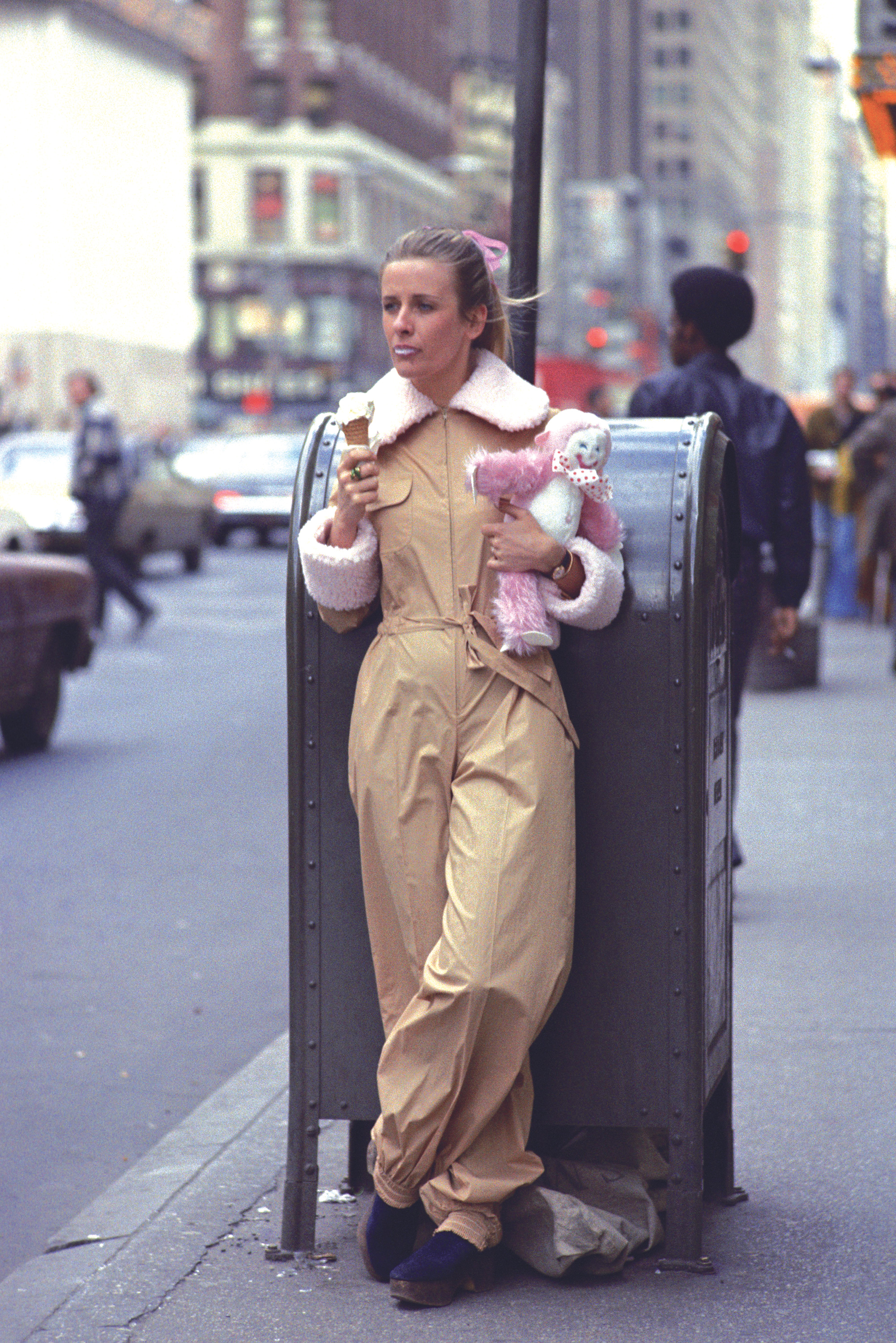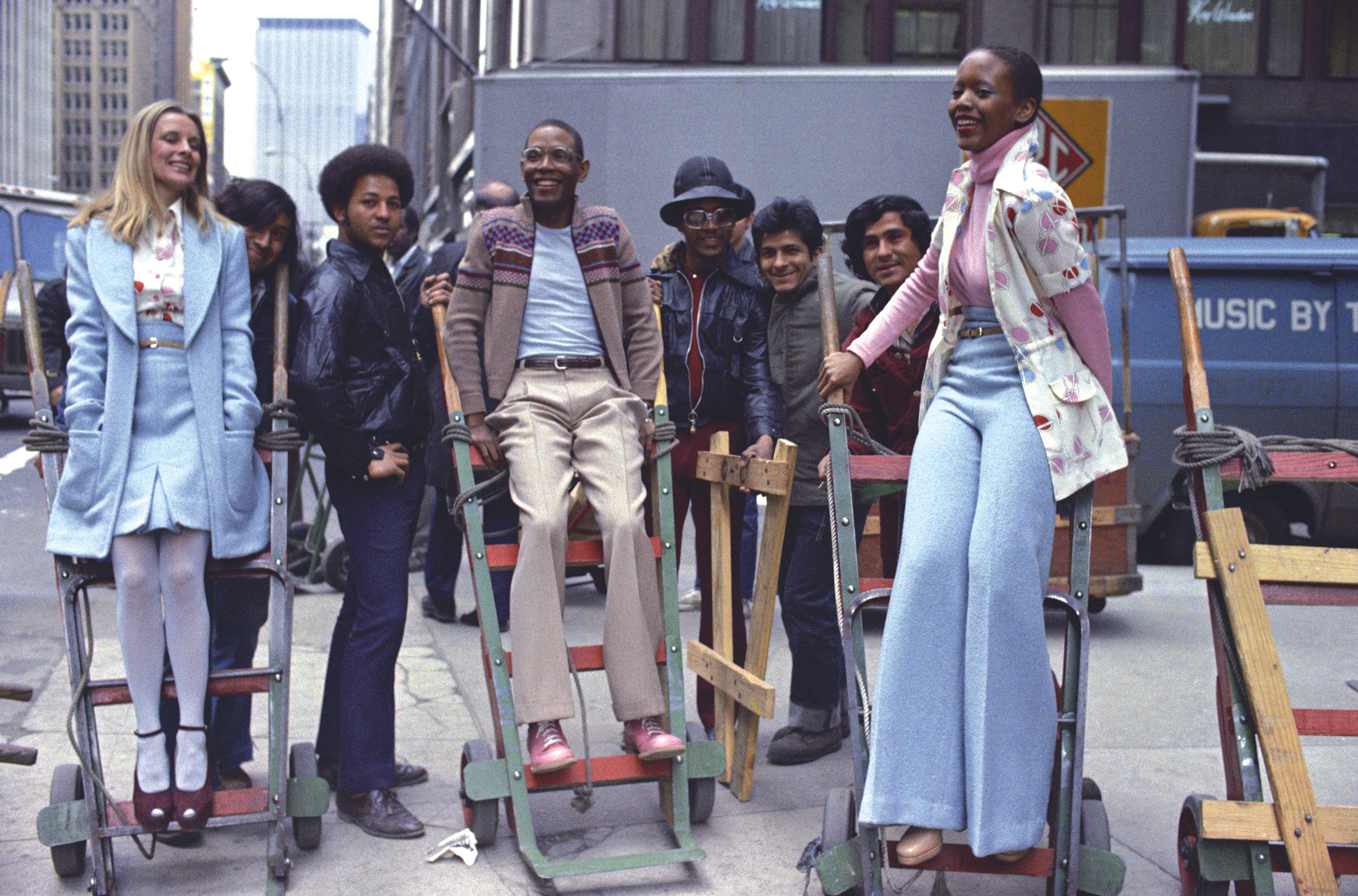WilliWear to Streetwear
Jonathan Michael Square
 Willi Smith for Digits, Fall/Winter 1972 Collection, 1972
Willi Smith for Digits, Fall/Winter 1972 Collection, 1972
Willi Smith was an industry wunderkind when he spotted
Bethann Hardison on the corner of Broadway and 40th
Street. He admired her style and assumed that she was a
designer. “At that time, my style wasn’t very girly. It was
just really sporty,” said Hardison.1 One of Smith’s assistants arranged for Hardison to visit his showroom, and
Smith asked her to join his design team. Upon learning
that she was a showroom assistant at Ruth Manchester
Ltd., he asked her to model for him, initiating a friendship
that would last until his death.
This encounter between Smith and Hardison encapsulates Smith’s design process, which was fueled by the individuality and eclectic styles that saturated the streets of New York City in the seventies and eighties. “People who wear WilliWear clothes make fashion,” Smith told Morning Call in 1984. “I feel the person who wears my clothes is the person who wants to express himself . . . he doesn’t want to be intimidated by clothing.”2 In Hardison’s words, “You used to see WilliWear everywhere. It was a brand that you would see everyone wearing on the street. That’s why editors started referring to it as streetwear.”3
Under the umbrella of what was then sportswear, Smith’s reverb loop with the street set in motion streetwear, a moniker that has been interpreted and misinterpreted ever since. Streetwear, as molded by Smith, was an inclusive term that aimed to democratize the way fashion was consumed and experienced. But despite Smith’s popularization of streetwear, or “street couture” as he came to call it, his influence on the category has been overshadowed by brands emerging in the nineties that were closely associated with hip-hop culture, such as FUBU and Karl Kani.
This encounter between Smith and Hardison encapsulates Smith’s design process, which was fueled by the individuality and eclectic styles that saturated the streets of New York City in the seventies and eighties. “People who wear WilliWear clothes make fashion,” Smith told Morning Call in 1984. “I feel the person who wears my clothes is the person who wants to express himself . . . he doesn’t want to be intimidated by clothing.”2 In Hardison’s words, “You used to see WilliWear everywhere. It was a brand that you would see everyone wearing on the street. That’s why editors started referring to it as streetwear.”3
Under the umbrella of what was then sportswear, Smith’s reverb loop with the street set in motion streetwear, a moniker that has been interpreted and misinterpreted ever since. Streetwear, as molded by Smith, was an inclusive term that aimed to democratize the way fashion was consumed and experienced. But despite Smith’s popularization of streetwear, or “street couture” as he came to call it, his influence on the category has been overshadowed by brands emerging in the nineties that were closely associated with hip-hop culture, such as FUBU and Karl Kani.
Although it is difficult to pinpoint when the dialogue
between the street and the fashion industry began,
various periods of fashion history exhibit mainstream
fashion sampling from subcultures and the working
class. Notable examples include the robe de gaulle
chemise dress inspired by the simplicity of peasant
clothing and first seen worn by Marie Antoinette in Vigée
Le Brun’s 1783 portrait of the queen, and Balenciaga’s
integration of aprons in his haute couture designs
during the fifties. Fueled by globalization, technological
innovation, and wars, American streetwear’s predecessor sportswear emerged during the late nineteenth century/early twentieth century as casual dress,
like the shirtwaist and activewear that provided alternatives to the contemporary high style of the late Victorian
and Edwardian periods. The breakdown of traditional
sociocultural divisions resulting from the youthquake,
the women’s movement, and the civil rights era accelerated the industry’s embrace of a more casual style and,
in some cases, antifashion within these communities.
Eventually, boundary-breaking baby boomers adapted
activewear, workwear, and military uniforms into their
wardrobes. They took these elements of dress outside of
their original contexts, subverted them into quotidian
style, and ultimately changed their meaning.4
“Streetwear, as molded by Smith, was an inclusive term that aimed to democratize the way fashion was consumed and experienced.”
Like countercultural youths in the sixties, seventies, and eighties, Smith welcomed nonconformity, but was also a garmento who cut his teeth on Seventh Avenue. After leaving Parsons, he landed his first major job at age twenty designing for Glenora, then sportswear brand Digits, where he led the label until 1973. When he formed WilliWear in 1976, Smith was settling in as part of the fashion establishment alongside designers like Halston, Perry Ellis, Anne Klein, and Giorgio Armani.
Smith’s take on streetwear was an eclectic yet irreverent twist on sportswear that elicited various identities from preppy silhouettes to billowing ensembles inspired by his passion for Indian and West African cultures. For example, his fall 1985 collection featured a plethora of themes, including colorful women’s suiting styled to transform the models into Spanish matadors juxtaposed against tapered plaid ensembles that emulated preppy country-club style. Smith focused on separates that allowed consumers to mix and match pieces from current and previous collections. He was a master of deconstructed suiting and had a penchant for gender-neutral silhouettes. He preferred plaids and stripes, bold prints and colors in natural, washable fibers that afforded the wearer both comfort and play.
 Willi Smith for Digits, Fall/Winter 1972 Collection, 1972
Willi Smith for Digits, Fall/Winter 1972 Collection, 1972Along with Arthur McGee, Scott Barrie, Patrick Kelly, and
Stephen Burrows, Smith worked at a time that welcomed
the creative perspective of African American designers.
He laid the groundwork for other designers of color interested in redefining who could have access to fashionable
designs. He told Women’s Wear Daily in 1972, “I have it
through my head now to give women simple, packaged
clothes that adapt to a lifestyle, rich or poor. People really
only need a few clothes. My idea is that a woman could go
into a store, pick up a pack in blue, green, and black and
in it would be five pieces that all work. The only change a
woman should have to make in her wardrobe for spring
into winter is a coat.”5
By designing pieces that favored a multitude of silhouettes, bodies, and gender identities, Smith was the first
designer to unite womenswear and menswear under the
same label.6 His gender-neutral designs extended to the
patterns he produced for Butterick and McCall’s, some
of which included images of men and women modeling
the same designs on the packaging and catalogue
editorial. He wanted his clothes to reach the widest
consumer base possible. Today, Smith’s fluid designs
would no doubt be championed and embraced by queer
and queer-allied consumers alike; they have influenced
labels that eschew gender norms, such as Eckhaus Latta,
Y/Project, Vaquera, and GmbH.
Parallel to and postdating the success of WilliWear, a
streetwear movement inspired by the early hip-hop
scene in New York City’s outer boroughs was accelerating. These Black-owned-and-designed labels like Cross
Colours, Karl Kani, and FUBU, which would become
popular shortly after Smith’s death, were formed outside
the fashion system. Smith, perhaps unwittingly, provided
a model for the success of these fashion companies.
Nineties streetwear designers Maurice Malone and April
Walker have both credited Smith for creating the first
bridge between the street and the runway,7 creating
fashion that was both inspired by and available to people
on the street.8
Today, luxury fashion and streetwear designers have joined forces. Designers like Virgil Abloh, Olivier Rousteing, and Kim Jones, who mix tailored suiting and couture-quality garments with T-shirts, sneakers, and hoodies, are leading Louis Vuitton, Balmain, and Dior. Brands like Supreme, A Bathing Ape (BAPE), and Kith have been elevated to luxury label status due, in part, to their overwhelming popularity among millennials and Gen Zers. Though these brands do not have the same affordable prices as WilliWear, the creators of these labels are driven to create fashion that reflects diverse audiences. Unlike early models of fashion, their aspirational luxury items are not inspired by or reserved solely for high-income consumers. Smith was the first to level the playing field.
Streetwear has come to describe a way of dressing among youth subcultures that is in contradistinction to—often in defiance of—high fashion. Although Smith was creating for and within traditional markets, he endeavored to refashion them for a wide and diverse audience through affordable collections and collaborations with music, art, and architecture. This model has been continuously reinterpreted and evolved by urban streetwear, high street, and luxury brands. Smith welcomed all to buy, wear, and enjoy his clothing, fueling a movement that is to this day helping us rethink accessibility and power in the fashion industry.
Jonathan Michael Square is a writer and professor of history at Harvard University, specializing in fashion and visual culture of the African diaspora. Square received a Ph.D. in history from New York University, a master’s from the University of Texas at Austin, and a bachelor’s from Cornell University.
Today, luxury fashion and streetwear designers have joined forces. Designers like Virgil Abloh, Olivier Rousteing, and Kim Jones, who mix tailored suiting and couture-quality garments with T-shirts, sneakers, and hoodies, are leading Louis Vuitton, Balmain, and Dior. Brands like Supreme, A Bathing Ape (BAPE), and Kith have been elevated to luxury label status due, in part, to their overwhelming popularity among millennials and Gen Zers. Though these brands do not have the same affordable prices as WilliWear, the creators of these labels are driven to create fashion that reflects diverse audiences. Unlike early models of fashion, their aspirational luxury items are not inspired by or reserved solely for high-income consumers. Smith was the first to level the playing field.
Streetwear has come to describe a way of dressing among youth subcultures that is in contradistinction to—often in defiance of—high fashion. Although Smith was creating for and within traditional markets, he endeavored to refashion them for a wide and diverse audience through affordable collections and collaborations with music, art, and architecture. This model has been continuously reinterpreted and evolved by urban streetwear, high street, and luxury brands. Smith welcomed all to buy, wear, and enjoy his clothing, fueling a movement that is to this day helping us rethink accessibility and power in the fashion industry.
Jonathan Michael Square is a writer and professor of history at Harvard University, specializing in fashion and visual culture of the African diaspora. Square received a Ph.D. in history from New York University, a master’s from the University of Texas at Austin, and a bachelor’s from Cornell University.
 Willi Smith for Digits, Fall/Winter 1972 Collection, 1972
Willi Smith for Digits, Fall/Winter 1972 Collection, 1972- Bethann Hardison, interviewed by the author, 6. June 11, 2019.
-
Polly Rayner, “WilliWear Designer Creates ‘Basic Clothes with a Sense of Humor,’” Morning Call 7. (October 21, 1984).
-
Bethann Hardison, interviewed by the author, July 12, 2019.
-
Ted Polhemus, “Street Wear,” in Encyclopedia of Clothing and Fashion, ed. Valerie Steele (Farmington Hills: Gale, Cengage Learning, 2004): 225–29; Jennifer Craik, “Fashioning Sports Clothing as Lifestyle Couture,” in Uniforms Exposed: From Conformity to Transgression (Oxford: Berg, 2005): 161–74.
-
Ki Hackney, “Willi,” Women’s Wear Daily (January 1, 8. 1972), 4–5.
-
Rajat Singh, “Fashion Flashback: Willi Smith,”
February 17, 2017, Link.
-
“Designers of the Hottest 90s Brands Assemble at
Liberty Fairs & Agenda Shows, Las Vegas,” September
10, 2018, Link; Taylor
Lovaas, “Maurice Malone Breaks Down Hip Hop and
Fashion History from Mojeans to the Hip Hop Shop
+ Gives Advice to Young Designers,” Aug. 19, 2016,
Link.
- Elena Romero, Free Stylin’: How Hip Hop Changed the Fashion Industry (Santa Barbara, CA: Praeger Publishers, 2012), x.

